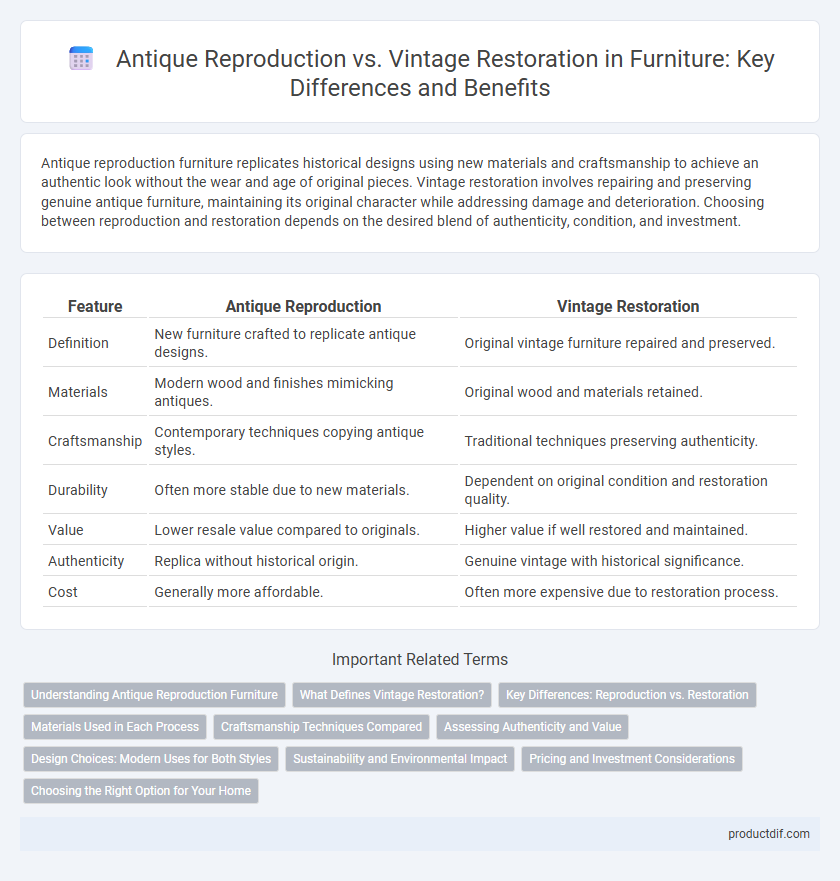Antique reproduction furniture replicates historical designs using new materials and craftsmanship to achieve an authentic look without the wear and age of original pieces. Vintage restoration involves repairing and preserving genuine antique furniture, maintaining its original character while addressing damage and deterioration. Choosing between reproduction and restoration depends on the desired blend of authenticity, condition, and investment.
Table of Comparison
| Feature | Antique Reproduction | Vintage Restoration |
|---|---|---|
| Definition | New furniture crafted to replicate antique designs. | Original vintage furniture repaired and preserved. |
| Materials | Modern wood and finishes mimicking antiques. | Original wood and materials retained. |
| Craftsmanship | Contemporary techniques copying antique styles. | Traditional techniques preserving authenticity. |
| Durability | Often more stable due to new materials. | Dependent on original condition and restoration quality. |
| Value | Lower resale value compared to originals. | Higher value if well restored and maintained. |
| Authenticity | Replica without historical origin. | Genuine vintage with historical significance. |
| Cost | Generally more affordable. | Often more expensive due to restoration process. |
Understanding Antique Reproduction Furniture
Antique reproduction furniture involves crafting new pieces that closely mimic the design, style, and craftsmanship of original antiques, using modern materials and techniques. These reproductions offer the aesthetic appeal of historical furniture without the fragility or high cost associated with genuine antiques. Understanding the distinctions between reproductions and vintage restoration helps buyers make informed decisions based on authenticity, durability, and value.
What Defines Vintage Restoration?
Vintage restoration involves carefully repairing and preserving original furniture pieces to maintain their historical integrity and character, often using period-appropriate materials and techniques. This process emphasizes retaining the authentic patina and wear that define the furniture's old-world charm and provenance. Unlike antique reproduction, vintage restoration prioritizes conservation over replication, ensuring the piece maintains its unique age-related value.
Key Differences: Reproduction vs. Restoration
Antique reproduction involves crafting new furniture pieces designed to closely mimic the style and craftsmanship of historical designs, often using modern materials and techniques to replicate the original aesthetics. Vintage restoration focuses on repairing and refurbishing existing aged furniture to preserve its original materials, patina, and structural integrity without altering its authentic character. The key difference lies in reproduction creating new items inspired by antiques, while restoration maintains and revitalizes genuine vintage pieces.
Materials Used in Each Process
Antique reproduction furniture primarily uses new, high-quality materials such as solid hardwoods like oak, cherry, and walnut, crafted to mimic historical designs with modern tools and techniques. Vintage restoration involves carefully preserving or repairing original materials, including aged wood, antique veneers, and period-specific hardware, to maintain authenticity and value. The choice of materials in vintage restoration prioritizes retaining original finishes and patinas, while reproduction emphasizes durability and consistency.
Craftsmanship Techniques Compared
Antique reproduction employs modern tools and materials to replicate original designs with precision, often using CNC machines and laser cutting for detailed woodworking. Vintage restoration prioritizes preserving original craftsmanship by repairing and refinishing existing materials, relying heavily on traditional techniques like hand carving, dovetail joinery, and natural finishes. While antique reproduction aims for exact aesthetic duplication, vintage restoration enhances authenticity by maintaining the furniture's historical integrity.
Assessing Authenticity and Value
Assessing authenticity and value in antique reproduction versus vintage restoration requires careful evaluation of materials, craftsmanship, and historical accuracy. Antique reproductions often use modern techniques and materials, which can affect their market value compared to restored vintage pieces that retain original components. Expert appraisals and provenance documentation play critical roles in distinguishing authentic vintage furniture from reproductions, directly impacting their desirability and pricing.
Design Choices: Modern Uses for Both Styles
Antique reproductions offer precise historical design details that blend seamlessly with contemporary interiors, providing durable craftsmanship suited for everyday use. Vintage restoration preserves original materials and patina, appealing to those who value authenticity and the rich character of aged wood and hardware. Both styles adapt to modern functions, with reproductions often enhancing ergonomics and restorations maintaining original aesthetics while integrating subtle upgrades for practical living.
Sustainability and Environmental Impact
Antique reproduction furniture uses sustainable materials and modern techniques to minimize waste and reduce environmental impact compared to vintage restoration, which often requires extensive repair and disposal of original parts. Producing new pieces through reproduction allows for controlled sourcing of eco-friendly wood and finishes, supporting sustainable forestry practices. Vintage restoration, while preserving historical value, can involve chemical treatments and high energy consumption, impacting sustainability goals negatively.
Pricing and Investment Considerations
Antique reproductions typically offer lower initial costs compared to vintage restorations, making them more accessible for budget-conscious buyers seeking classic styles. Vintage restorations, however, often require significant investment due to specialized craftsmanship and authentic material sourcing but can yield higher long-term value in the collectors' market. Pricing in vintage restoration fluctuates based on the piece's historical significance and condition, while reproduction pricing is generally more stable and predictable.
Choosing the Right Option for Your Home
Antique reproduction offers the charm of classic design with modern durability, making it ideal for homeowners seeking authentic style without the fragility of original pieces. Vintage restoration preserves the unique history and craftsmanship of existing furniture, perfect for those who value genuine patina and storytelling in their decor. Selecting between reproduction and restoration depends on your preference for authenticity versus practicality and the level of maintenance you are prepared to undertake.
Antique reproduction vs Vintage restoration Infographic

 productdif.com
productdif.com